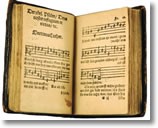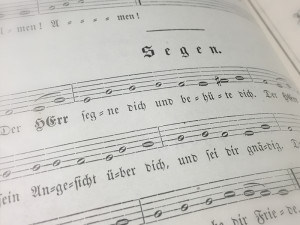by Jonathan A. Swett
One of the central figures of church music during the Reformation period was Martin Luther, who expressed on numerous occasions that, next to theology, he accorded music the highest praise. In contrast to other notable reformers of his day, Luther believed that music was “a gift of God to be nurtured and used by man for his delight and edification, as a means for giving praise to the Creator, and as a vehicle for the proclamation of God’s Word.”[1] It follows suit that the liturgical singing and hymnody that took place was and still is one of the most significant influences of Luther upon the worship life of the Lutheran church (and many other churches as well). Thanks in large part to the scholarly work of Dr. Carl Schalk much information is accessible for our understanding on this topic.
One of Luther’s paradigms was the use of language in worship that could be understood—if it was Latin that was understood, it was Latin that should be used. More common, however, especially in small towns and villages, German was the vernacular language and Luther went to great lengths to translate Scripture, orders of service, and liturgical songs so God’s people could understand what He communicated to them in the Mass (Divine Service) and they could respond in such a way as to foster mutual edification. The most significant difference between Catholic and Lutheran worshipping communities in the 16th century was the emergence of the chorale and the music that developed around it. Dr. Schalk elegantly articulates that “Luther viewed the congregational hymn or chorale as an integral and vital part of the liturgy and not merely as a general Christian song loosely attached to worship. It was liturgical hymnody—in which doxa [glory or praise] and dogma [teaching or belief] were united in doxological proclamation, and in which the people joined together in praise, mutual expression of the faith, and in the simple, practical, and liturgical demonstration of the universal priesthood of all believers—that was the genius of the developing hymnody of the early Lutheran Reformation.”[2]
Five different sources are cited in the promulgation of the Lutheran chorale. The first is the treasury of Gregorian chant. Although the texts and melodies were often slightly altered, its usage expresses the emphasis the Reformation church placed on its traditional roots that had nourished Christians for centuries. A second source, known as Leisen, was a group of pre-Reformation German folk hymns characterized by the use of some form of “Kyrie eleison” as the conclusion of each stanza. Cantios were pre-Reformation Latin songs of religious nature, but not directly associated with the liturgy. I wrote for this blog in December about the hymn “From Heaven Above to Earth I Come”—an example of the fourth source, contrafaction—providing a sacred text to an already existing popular secular melody. Lastly, Luther encouraged the creation of newly-composed hymns for people to make their own both in praise of God and proclamation of the Gospel. Luther led the way with the hymns he created based on Psalms, the Sanctus, and catechismal themes. This writing and composing of Luther inspired the creation of many more hymns for congregational use by other authors and composers as well. (Examples of hymns in Lutheran Service Book of each type are below.)
Though this article isn’t exhaustive of its subject matter, “Singing the Reformation” wouldn’t be complete without digging into Luther’s most famous chorale, “Ein feste Burg ist unser Gott” (“A Mighty Fortress Is Our God”). While it is true Luther was known to frequent taverns, it is a common misconception that this chorale is necessarily an example of contrafaction because of its “bar” form misnomer. Rather, “Bar form” (from the medieval German term for ‘strophe’—Bar) refers to a form made popular in the tradition of the Meistersingers, which consists of a three-part poetic and musical structure. The first part (A) was referred to as the Stollen and consisted of two subparts (ab). The second part was a repetition of the Stollen, followed by the Abgesang (B) which consisted of three subparts (cde). This can also be expressed as: A :|| B (notice the musical notation for “repeat” which consists of two ‘bars’ and two dots; another misconception).

In the present day, when ‘singing the Reformation’ and singing throughout the entire church year, it is worth noting that the hymns of Luther and others of the period were meant to convey a message rather than create a mood. Their objectivity was firmly grounded as a confession of faith rather than an expression of personal feelings. The mood of early Lutheran hymnody was “a vigorous proclamation of doxological praise in texts which spoke the Good News plainly and directly, and melodies which matched in their strength and vigor the proclamation of that same Gospel.”[3] The congregations in which this music still rings forth is evidence of faithfulness to the theological and liturgical understandings, motivations, and foundations which motivated the church of the Reformation—a church in which music for worship and the liturgy was (and can still be!) seen as vital, exciting, and faithful to the challenge of praise and proclamation of the triune God!
Jonathan A. Swett is Kantor of Our Savior Evangelical Lutheran Church and School, Hartland, Michigan.
Chorale source hymn examples in Lutheran Service Book
Gregorian chant: 499, 498, 655, 332, 778, 458, 460, 459, 617, 942, 947, 960, 434
Leisen: 459, 768, 382, 581, 755, 627
Cantios: 386, 375
Contrafaction: 358, 880, 450, 745
Newly-composed (Luther): 607, 823, 656, 960, 954, 581, 766, 406, 627
Newly-composed (others): 615, 562, 714, 555,947, 434, 389, 876
[1] Carl Schalk, Music in Early Lutheranism (St. Louis: Concordia Publishing House, 2001), 16.
[2] Carl Schalk, “German Hymnody,” in Hymnal Companion to the Lutheran Book of Worship (Philadelphia: Fortress Press, 1981), 19.
[3] Ibid., 23.
